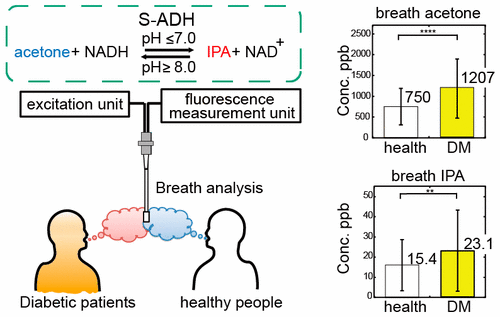当前位置:
X-MOL 学术
›
Anal. Chem.
›
论文详情
Our official English website, www.x-mol.net, welcomes your
feedback! (Note: you will need to create a separate account there.)
Biochemical Gas Sensors (Biosniffers) Using Forward and Reverse Reactions of Secondary Alcohol Dehydrogenase for Breath Isopropanol and Acetone as Potential Volatile Biomarkers of Diabetes Mellitus
Analytical Chemistry ( IF 6.7 ) Pub Date : 2017-11-09 00:00:00 , DOI: 10.1021/acs.analchem.7b03191 Po-Jen Chien 1 , Takuma Suzuki 1 , Masato Tsujii 1 , Ming Ye 2 , Isao Minami 3 , Kanako Toda 4 , Hiromi Otsuka 5 , Koji Toma 2 , Takahiro Arakawa 2 , Kouji Araki 4 , Yasuhiko Iwasaki 6 , Kayoko Shinada 5 , Yoshihiro Ogawa 3, 7, 8 , Kohji Mitsubayashi 1, 2
Analytical Chemistry ( IF 6.7 ) Pub Date : 2017-11-09 00:00:00 , DOI: 10.1021/acs.analchem.7b03191 Po-Jen Chien 1 , Takuma Suzuki 1 , Masato Tsujii 1 , Ming Ye 2 , Isao Minami 3 , Kanako Toda 4 , Hiromi Otsuka 5 , Koji Toma 2 , Takahiro Arakawa 2 , Kouji Araki 4 , Yasuhiko Iwasaki 6 , Kayoko Shinada 5 , Yoshihiro Ogawa 3, 7, 8 , Kohji Mitsubayashi 1, 2
Affiliation

|
This study describes two biosniffers to determine breath acetone and isopropanol (IPA) levels and applies them for breath measurement in healthy subjects and diabetic patients. Secondary alcohol dehydrogenase (S-ADH) can reduce acetone and oxidize nicotinamide adenine dinucleotide (NADH to NAD+) in a weak acid environment. NADH can be excited by 340 nm excitation lights and subsequently emit 490 nm fluorescence. Therefore, acetone can be measured by the decrease in NADH fluorescence intensity. S-ADH can also oxidize IPA and reduce NAD+ to NADH when it is in an alkaline environment. Thus, IPA can be detected by the increase of fluorescence. The developed biosniffers show rapid response, high sensitivity and high selectivity. The breath acetone and IPA analysis in healthy subjects shows that the mean values were 750.0 ± 434.4 ppb and 15.4 ± 11.3 ppb. Both acetone and IPA did not show a statistical difference among different genders and ages. The breath acetone analysis for diabetic patients shows a mean value of 1207.7 ± 689.5 ppb, which was higher than that of healthy subjects (p < 1 × 10–6). In particularly, type-1 diabetic (T1D) patients exhaled a much higher concentration of acetone than type-2 diabetic (T2D) patients (p < 0.01). The breath IPA also had a higher concentration in diabetic patients (23.1 ± 20.1 ppb, p < 0.01), but only T2D patients presented a statistical difference (23.9 ± 21.3 ppb, p < 0.01). These findings are worthwhile in the study of breath biomarkers for diabetes mellitus diagnosis. Additionally, the developed biosniffers provide a new technique for volatolomics research.
中文翻译:

生化气体传感器(Biosniffer),利用二级酒精脱氢酶对异丙醇和丙酮的正向和反向反应作为糖尿病的潜在挥发性生物标志物
这项研究描述了两个生物嗅探器,用于确定呼气中丙酮和异丙醇(IPA)的水平,并将其应用于健康受试者和糖尿病患者的呼气测量。在弱酸环境中,仲醇脱氢酶(S-ADH)可以还原丙酮,并将烟酰胺腺嘌呤二核苷酸(NADH氧化为NAD +)。NADH可以被340 nm激发光激发,随后发出490 nm荧光。因此,可以通过降低NADH荧光强度来测量丙酮。S-ADH还可以氧化IPA并减少NAD +在碱性环境中会吸收到NADH。因此,可以通过荧光的增加来检测IPA。发达的生物嗅探器显示出快速反应,高灵敏度和高选择性。健康受试者的呼吸丙酮和IPA分析表明,平均值分别为750.0±434.4 ppb和15.4±11.3 ppb。丙酮和IPA在不同性别和年龄之间均无统计学差异。糖尿病患者的呼气丙酮分析显示平均值为1207.7±689.5 ppb,高于健康受试者的平均值(p <1×10 –6)。特别是,与2型糖尿病(T2D)患者相比,1型糖尿病(T1D)患者呼出的丙酮浓度要高得多(p<0.01)。糖尿病患者的呼吸IPA浓度也较高(23.1±20.1 ppb,p <0.01),但只有T2D患者表现出统计学差异(23.9±21.3 ppb,p <0.01)。这些发现在用于糖尿病诊断的呼吸生物标志物的研究中是值得的。此外,发达的生物嗅探器为挥发组学研究提供了一种新技术。
更新日期:2017-11-09
中文翻译:

生化气体传感器(Biosniffer),利用二级酒精脱氢酶对异丙醇和丙酮的正向和反向反应作为糖尿病的潜在挥发性生物标志物
这项研究描述了两个生物嗅探器,用于确定呼气中丙酮和异丙醇(IPA)的水平,并将其应用于健康受试者和糖尿病患者的呼气测量。在弱酸环境中,仲醇脱氢酶(S-ADH)可以还原丙酮,并将烟酰胺腺嘌呤二核苷酸(NADH氧化为NAD +)。NADH可以被340 nm激发光激发,随后发出490 nm荧光。因此,可以通过降低NADH荧光强度来测量丙酮。S-ADH还可以氧化IPA并减少NAD +在碱性环境中会吸收到NADH。因此,可以通过荧光的增加来检测IPA。发达的生物嗅探器显示出快速反应,高灵敏度和高选择性。健康受试者的呼吸丙酮和IPA分析表明,平均值分别为750.0±434.4 ppb和15.4±11.3 ppb。丙酮和IPA在不同性别和年龄之间均无统计学差异。糖尿病患者的呼气丙酮分析显示平均值为1207.7±689.5 ppb,高于健康受试者的平均值(p <1×10 –6)。特别是,与2型糖尿病(T2D)患者相比,1型糖尿病(T1D)患者呼出的丙酮浓度要高得多(p<0.01)。糖尿病患者的呼吸IPA浓度也较高(23.1±20.1 ppb,p <0.01),但只有T2D患者表现出统计学差异(23.9±21.3 ppb,p <0.01)。这些发现在用于糖尿病诊断的呼吸生物标志物的研究中是值得的。此外,发达的生物嗅探器为挥发组学研究提供了一种新技术。











































 京公网安备 11010802027423号
京公网安备 11010802027423号